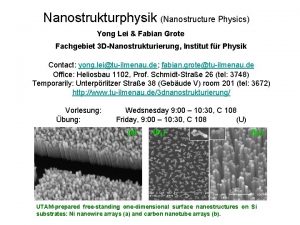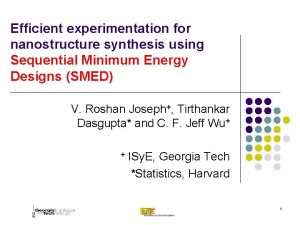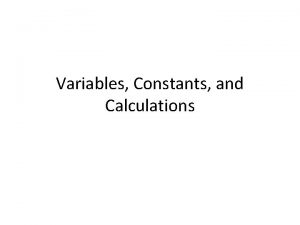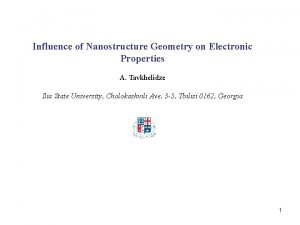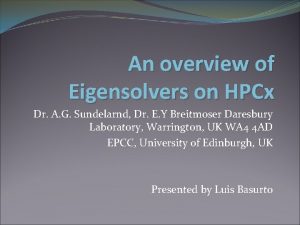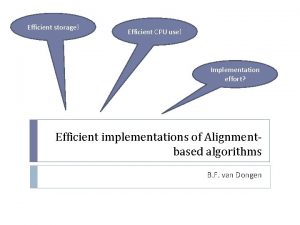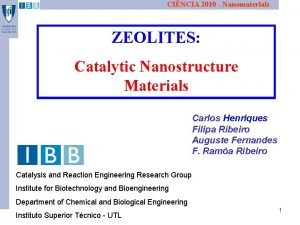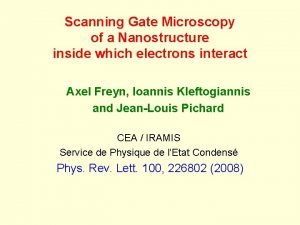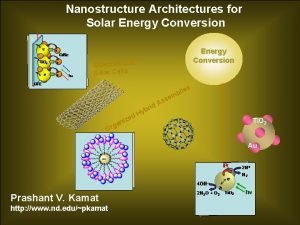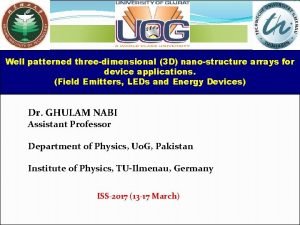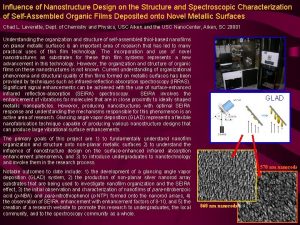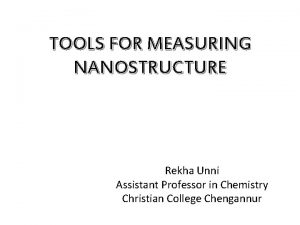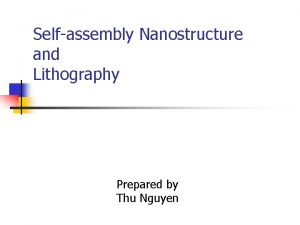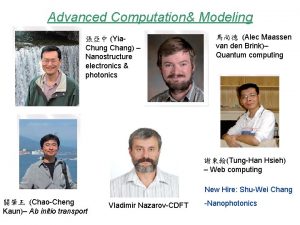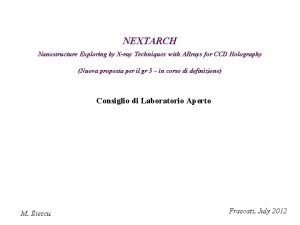Efficient Eigensolvers for Largescale Electronic Nanostructure Calculations Stanimire



















- Slides: 19

Efficient Eigensolvers for Large-scale Electronic Nanostructure Calculations ________________________ Stanimire Tomov 1 Andrew Canning 2, Jack Dongarra 1, Osni Marques 2 Christof Vömel 2 and Lin-Wang 2 Innovative Computing Laboratory 1 University of Tennessee Supported by: U. S. DOE, Office of Science SC 05, Seattle 11/16/2005 Alex Zunger Gabriel Bester Joonhee An Alberto Franceschetti Wesley Jones Kim Kwiseon Peter Graf Lawrence Berkeley National Laboratory 2 Computational Research Division Jack Dongarra Julien Langou Stanimire Tomov Lin-Wang Andrew Canning Osni Marques Christof Vömel M. Claudia Troparevsky 1

Outline • Background • Problem formulation • Solution approach – Iterative Conjugate Gradients (CG) type eigensolvers • Preconditioning – The Bulk-band (BB) preconditioner • Numerical results • Conclusions 2

Background • Quantum dots – Tiny crystals ranging from a few hundred to few thousand atoms in size; made by humans – Electronic properties critically depend on shape and size – Colors of light absorbed and emitted can be tuned by the quantum dot size • Absorbed energy can lift an electron from its valence band to its conduction band (generate electrical current) • Electron falling back from conduction to valence band lead to loss of energy, emitted as light • The mathematical simulation leads to eigen-value problems Total electron charge density of a quantum dot of gallium arsenide, containing just 465 atoms. Quantum dots of the same material but different sizes have different band gaps and emit different colors – Different electronic properties than their bulk material • But still, bulk material properties may be useful: we found ways to use them in designing preconditioners that would significantly accelerate quantum dots electronic structure calculations 3

Problem formulation • Solve a single particle Schrödinger-type equation (E) (- 0. 5 + V ) i = i i with periodic boundary conditions • Many electronic nano-structure calculations lead to it • Leads to a discrete eigenvalue problem H i = Ei i , where H is Hermitian • Many additional requirements – Find a few (4 -10) interior eigenvalues closest to a given point Eref – Repeated eigenvalues are allowed (degeneracy up to 4), etc. • The problem size requires a parallel iterative solution approach 4

Solution approach • Phase 1: Iterative eigen-solvers – Conjugate Gradients (CG) type with spectral transformation • Based on their previous successful use in the field • Folded spectrum: solve for (H-Eref)2 to get interior eigen-states (L. W. Wang & A. Zunger, 1993) – Developed library of 3 non-linear CG eigen-solvers – The library includes the A. Knyazev’s LOBPCG method • Supports blocking • Supports preconditioning • Developed and integrated in Nano. PSE (S. Tomov and J. Langou) 5

Solution approach … – We use the Nanoscience Problem Solving Environment (Nano. PSE) package • Integrate various nano-codes (developed over ~10 years) • Its design goal: provide a software context for collaboration – Features easy install; runs on many platforms, etc. • Collected and maintained by Wesley Jones (NREL) – Results: • 43% improvement in speed and 49% in number of matrix-vector products – On a In. As nanowire system of ~ 70, 000 atoms, eigen-system of size 2, 265, 827 (A. Canning and G. Bester) • Results are good: reference algorithm & implementation were very efficient • But limited by the effectiveness of the available preconditioner • Phase 2: Preconditioning 6

Preconditioning • Preconditioning: term coming from accelerating the convergence of iterative solvers for linear systems Ax = b in particular, find operator/preconditioner T “ A-1” s. t. (TA) x = Tb be “easier” to solve • Preconditioning for eigenproblems – Harder problem / not “as straightforward” – Can be shown that efficient preconditioners for linear systems are efficient preconditioners for CG-type eigensolvers 7

Bulk Band (BB) Preconditioner Basic idea: • Use the electronic properties of the bulk materials constituent for the nanostructure in designing a preconditioner • What does it mean and how? 8

BB preconditioner 9

BB preconditioner • Find electronic properties of the bulk materials: – Solve (E) on infinite crystal (bulk material) – Because of the periodicity solve just on the primary cell (much smaller problem); Find solution in form (Bloch theorem): nk (r ) = unk( r) eikr, unk (r+A) = unk( r) – Denote span{ nk } as BB space • Denote by HBB the Hamiltonian stemming from a bulk problem; if BB space, HBB-1 is easy to compute • Note that if H stems from a bulk problem HBB-1 is the exact preconditioner for H (=H-1) 10

BB preconditioner, continued … • Decompose the current residual R as R = QBB R + (R – QBB R) where QBB is the L 2 projection in the BB space • Use HBB-1 to precondition the QBB R component of R and a diagonal preconditioner D-1 for the (R–QBB R) component, i. e. (1) T R HBB-1 QBB R + D-1 (R – QBB R) • TR in (1) is just one example … • Preconditioners of form (1) are refered to in the literature as additive; another variation is (2) T R HBB-1 QBB R + w D-1 R, where w>0 is a dumping parameter 11

BB preconditioner, continue … • (2) can be viewed as a multilevel (two-level) preconditioner: “correct” the low frequency components of R with HBB-1 and “smooth” the high frequencies with D-1 • How to choose w in (2); also present in (1)? • Avoid the problem of determining it by considering a multiplicative multilevel version of the BB preconditioner: r 1 = D-1 R r 2 = r 1 + HBB-1 QBB (R – H r 1) T R r 2 + D-1 (R – H r 2) 12

Numerical results • Tests on a bulk problem 64 atoms of Cd 48 -Se 34 512 atoms of Cd 48 -Se 34 • The BB preconditioner should be most efficient for this case (speedup of factor 3, increasing with problem size increase) • We start with arbitrary initial guess • Here BB space dimension is 1. 5% of solution space dimension 13

Numerical results • Tests with “perturbed” potential (simulate a quantum dot) 64 atoms of Cd 48 -Se 34 512 atoms of Cd 48 -Se 34 • Factor of 2 speedup • Increasing with increasing problem size 14

Numerical results • Tests with “perturbed” potential (simulate a quantum dot) • Localized wave-functions with density charge confinement simulating a quantum dot 15

Numerical results • Various perturbations with the BB multiplicative preconditioner 64 atoms of Cd 48 -Se 34 512 atoms of Cd 48 -Se 34 • Not that sensitive to perturbation increase 16

Numerical results • BB vs diagonal preconditioning on a bigger system (4096 atoms of Cd 48 -Se 34) for various perturbations BB multiplicative preconditioning Diagonal preconditioning • Speedup exceeding a factor of 3 • Goes to about factor of 7 for perturbation 4 17

Numerical results • Comparison of diagonal (in red) vs BB preconditoining (in green) using folded spectrum; (H-Eref)2 64 atoms of Cd 48 -Se 34 512 atoms of Cd 48 -Se 34 • The speedup from the H case is multiplied by a factor of 2 • A speedup of factor 4 for small problems; increasing with problem size increase 18

Conclusions • A new preconditioning technique was presented • Numerical results show the efficiency of the BB preconditioning – A factor of 4 speedup for small problems with folded spectrum (compared to diagonal preconditioning) – Increased efficiency with problem size increase • More testing has to be done – On bigger problems – With real quantum dots 19
 Nanostructure physics
Nanostructure physics Productively efficient vs allocatively efficient
Productively efficient vs allocatively efficient Productively efficient vs allocatively efficient
Productively efficient vs allocatively efficient Productively efficient vs allocatively efficient
Productively efficient vs allocatively efficient Productively efficient vs allocatively efficient
Productively efficient vs allocatively efficient C b a d
C b a d Types of connections in steel structures
Types of connections in steel structures Is the electronic exchange of money or scrip
Is the electronic exchange of money or scrip Electronic field production examples
Electronic field production examples Lek med geometriska former
Lek med geometriska former Bris för vuxna
Bris för vuxna En lathund för arbete med kontinuitetshantering
En lathund för arbete med kontinuitetshantering Bra mat för unga idrottare
Bra mat för unga idrottare Etik och ledarskap etisk kod för chefer
Etik och ledarskap etisk kod för chefer Publik sektor
Publik sektor Ellika andolf
Ellika andolf Datorkunskap för nybörjare
Datorkunskap för nybörjare Antikt plagg i rom
Antikt plagg i rom Steg för steg rita
Steg för steg rita Ministerstyre för och nackdelar
Ministerstyre för och nackdelar
